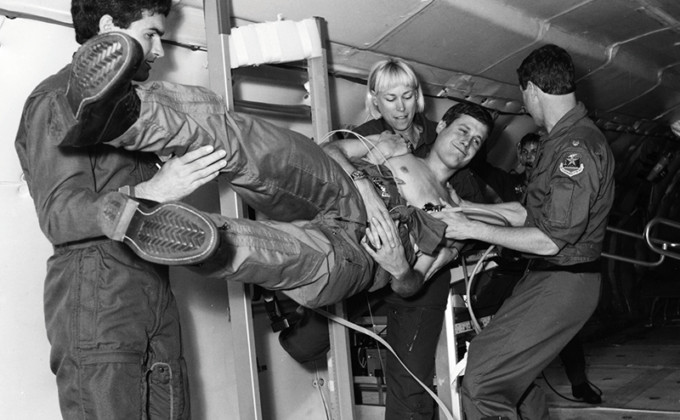
The longtime collaboration with NASA began with UT Southwestern professor of internal medicine, Dr. Gunnar Blomquist, whom Dr. Levine called the UT Southwestern space researchers’ intellectual leader. The Swedish cardiologist joined the UT Southwestern faculty in 1965 and participated in the Bed Rest and Training study that showed rest weakened the heart. His professional interests centered on the effects of exercise and deconditioning on the circulation, which led to his exploration of how the heart adapted to spaceflight.
Dr. Blomquist’s bold and innovative experiments, which included having the first heart catheter placed in an astronaut, made him the world’s premier expert on the effects of gravity on the cardiovascular system. (Without gravity, the heart doesn’t have to work as hard, he found, and it becomes weaker in space.) He was the principal investigator on numerous experiments on the Space Shuttle as well as the Russian Mir Space Station and may have the world’s record for sending three of his trainees into space as NASA payload specialists.
Dr. Gaffney’s experience in cardiac research, echocardiography and human physiology led to his being selected as a payload specialist on the first shuttle mission dedicated to biomedical research. He participated in the first invasive measurements of central venous blood pressure with a catheter placed in his own heart several days prior to the flight and removed after in-flight measurements were completed. The crew on board conducted more than 18 experiments during the nine-day flight, bringing back information for more peer-reviewed, published medical data than from any previous NASA flight.
Dr. Buckey served as project manager for the spaceflight experiment “Cardiovascular Adaptation to Zero-Gravity” on Spacelab Life Sciences 1 in 1991 and was a back-up payload specialist for Spacelab Life Sciences 2 in 1993. In 1998 he was chosen to serve as a payload specialist aboard the Neurolab 1. Dr. James Pawelczyk also was selected as a co-investigator on the Neurolab flight because of his experience with microneurography, a difficult technique involving the recording of neural signals from the brain to the blood vessels. During a 17-day flight, Drs. Buckey and Pawelczyk and the other five crew members aboard Space Shuttle Columbia, served as both subjects and conductors of 26 experiments looking at microgravity’s effects on the brain and nervous system. The experiments they performed as part of UT Southwestern’s collaboration with investigators from Vanderbilt University, Virginia Commonwealth University and the German Aerospace Center were the most ambitious experiments ever attempted in the history of manned spaceflight. The men orbited the Earth 256 times and covered 6.3 million miles during the flight. Later Dr. Pawelczyk also flew on two Shuttle-Mir flights as a co-investigator. He received a NASA Young Investigator Award in 1998.
The scientific results obtained from the Spacelab experiments led scientists to a greater understanding of how the body adapts to space flight and how it adjusts to Earth’s gravity, according to the National Space Biomedical Research Institute (NSBRI). Dr. Levine continues UT Southwestern’s partnership with NASA as leader of the Cardiovascular Alterations Team within the NSBRI Science and Technology Program. The team aims to determine the effect of long-duration spaceflight on the heart and blood vessels and find ways to reduce the risks and improve management of cardiovascular disease.
In other words, UT Southwestern – 22 years after its first foray into space – is still charting a course to better cardiovascular health for mankind by looking beyond the boundaries of Earth.
Dr. Gaffney is now a professor of medicine at Vanderbilt University Medical Center. Dr. Buckey is now a professor of medicine at the Geisel School of Medicine at Dartmouth. Dr. Pawelczyk is now an associate professor of physiology and kinesiology at Pennsylvania State University. Dr. Blomquist is deceased.